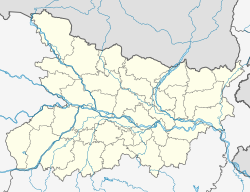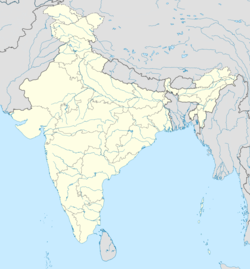Kahalgaon
This article may require copy editing for grammar, style, cohesion, tone, or spelling. (April 2025) |
This article needs additional citations for verification. (July 2025) |
Kahalgaon
Colgong | |
|---|---|
Town | |
| Nickname: CITY OF 7th NTPC | |
| Coordinates: 25°16′N 87°13′E / 25.27°N 87.22°E | |
| Country | |
| State | Bihar |
| District | Bhagalpur |
| Subdivision | Kahalgaon subdivision |
| Block | Kahalgaon block |
| Assembly constituency | Kahalgaon constituency and Pirpainti constituency |
| Ward | 17 |
| Government | |
| • Type | Municipality |
| Area | |
• Total | 297 km2 (115 sq mi) |
| • Town | 6 km2 (2 sq mi) |
| Elevation | 16 m (52 ft) |
| Population (2023) | |
• Total | 55,000 |
| • Density | 190/km2 (480/sq mi) |
| Language | |
| • Official | Hindi[1] |
| • Additional official | Urdu[1] |
| • Regional | Angika[2] |
| Time zone | UTC+5:30 (IST) |
| Vehicle registration | BR 10 |
Kahalgaon (formerly known as Colgong during British rule) is a municipality town and one of 3 sub-divisions of Bhagalpur District in the state of Bihar, India.[3] It is located close to the Vikramashila, that was once a famous centre of Buddhist learning across the world, along with Nalanda, during the Pala dynasty. The Kahalgaon Super Thermal Power Plant (KhSTPP) is located near the town (3 km). Kahalgaon was capital (capital-in-exile) of Jaunpur Sultanate (1494–1505).[4]
Etymology
[edit]Kahalgaon is named after Kahol Rishi, the father of the saint named Ashtavakra (popularly known in the Mahabharata). Ashtavakra was one of the greatest saints who got his body Vakara from eight places and was named Ashtavakra. He set free his father from jail of the king by winning a contest on Shastra.
Tourism
[edit]Vikramashila Mahavihara
[edit]Vikramashila (vill-Antichak) is located 13 km from Kahalgaon. It is famous for ancient Vikramashila, founded by Dharmapala, a Pala king, in the 8th century; the educational institution served as a learning center of Tantric Buddhism. At the center of the building was a huge Buddhist temple, surrounded by 108 smaller temples. The remains excavated from this university made Vikramashila one of the most important historic places near Kahalgaon. It produced eminent scholars who were often invited by foreign countries to spread Buddhist learning, culture and religion. The most distinguished and eminent among all was Atisa Dipankara, the founder of Lamaism in Tibet. Subjects like theology, philosophy, grammar, metaphysics, and logic were taught here, but the most important branch of learning was tantrism.
Vikramshila Gangetic Dolphin Sanctuary
[edit]Vikramshila Gangetic Dolphin Sanctuary is located in Bhagalpur District of Bihar, India. The sanctuary is a 60 kilometers stretch of the Ganges River from Sultanganj to Kahalgaon in Bhagalpur district. Notified as the Vikramshila Gangetic Dolphin Sanctuary in 1991, it is the protected area for the endangered Gangetic dolphins in Asia. Once found in abundance, only a few hundred remain, of which half are found here.
Archaeological Museum, Vikramshila
[edit]Archaeological Museum, Vikramshila, which was established by the central government in 2004, It is situated at Vikramshila near Kahalgaon in Bihar.
Baba Bateshwar Nath Temple
[edit]The Baba Bateshwar Nath Temple is situated on the banks of the river Ganges near Vikramshila. This temple is an ancient Shiva temple with lots of devotees coming here in the month of Sharavan
Shiv Kumari Mountain
[edit]Shiv Kumari Mountain is mainly divided into two parts — the small mountain and the big mountain, there is a mosque on the big mountain, and there is a Shiva temple on the small mountain. This mountain is located in the east direction of Kahalgaon Railway Station. This is the highest mountain of Kahalgaon.
History
[edit]
Vikramashila: Close to Kahalgaon are the remains of the great Vikramashila Mahavihara, which was famous as a center of advanced learning across the world in ancient times. Mahmud Shah's Tomb: Kahalgaon also houses the Tomb of Mahmud Shah, the last independent king of erstwhile Bengal, who died here a few days after his army was defeated by Sher Shah. The SSV college, which is a degree college, was the main stock center of business of indigo (Nil, used for white cloth) at the time of British rule in India.
Medieval era
[edit]Kahalgaon was an education hub in the Middle Ages. Vikramashila was one of the two most important centers of Buddhist learning in India, along with Nalanda during the Pala dynasty. Vikramashila was established by King Dharmapala (rule: 770–810 CE) in response to a supposed decline in the quality of scholarship at Nālandā. Atisha, the renowned Pandita, is sometimes listed as a notable abbot.
Modern era
[edit]In the vicinity of the town now stands the thermal power project from NTPC, known as Kahalgaon Super Thermal Power Station (KhSTPP). The project has an installed capacity of 2340 MW developed in two stages. The first stage had 4 units of 210 MW capacity each and the second expansion had 3 units of 500 MW.
NTPC Kahalgaon
[edit]The National Thermal Power Corporation, popularly known as NTPC was also set up in Kahalgaon in the year 1985, the unit has been named Kahalgaon Super Thermal Power Plant (KhSTPP) owing to its relatively large production capacity. The total installed capacity of the plant is 2340 megawatts, Stage-I: 840 MW and Stage-II: 1500 MW.
NTPC power plant uses Rajmahal Coal Fields of Eastern Coalfields Limited (Lalmatiya) as the coal source for producing electricity. The river Ganges serves as a major source of water needed for production. Normally PLF is about 70% here because of the lack of coal. It has 4x210 MW units of Russian make and 3x500 MW units of German make supplied by BHEL. This power plant serves as a beneficiary for West Bengal, Bihar, Jharkhand, Orissa, Sikkim states.
In art and literature
[edit]An anonymous tomb on some rocks on the Ganga River nearby is the subject of a painting by J. M. W. Turner (Rocks at Colgong on the Ganges), an engraving of which, together with a poetical illustration by Letitia Elizabeth Landon was published in Fisher's Drawing Room Scrap Book, 1839.[5]
Demographics
[edit]| Year | Pop. | ±% |
|---|---|---|
| 1872 | 5,239 | — |
| 1881 | 5,672 | +8.3% |
| 1891 | 5,145 | −9.3% |
| 1901 | 5,738 | +11.5% |
| 1911 | 4,297 | −25.1% |
| 1921 | 5,413 | +26.0% |
| 1931 | 5,233 | −3.3% |
| 1941 | 6,523 | +24.7% |
| 1951 | 7,515 | +15.2% |
| 1961 | 9,873 | +31.4% |
| 1971 | 10,543 | +6.8% |
| 1981 | 14,030 | +33.1% |
| 1991 | 17,899 | +27.6% |
| 2001 | 22,049 | +23.2% |
| 2011 | 33,700 | +52.8% |
| Source: CENSUS OF INDIA, 1911. VOLUME V[6] District Census Handbook[7] | ||
The Kahalgaon Nagar Panchayat has population of 33,700 of which 17,952 are males while 15,748 are females as per report released by Census India 2011.
Population of Children with age of 0-6 is 5221 which is 15.49% of total population of Kahalgaon Nagar Panchyat(NP). In Kahalgaon Nagar Panchayat, Female Sex Ratio is of 877 against state average of 918. Moreover, Child Sex Ratio in Kahalgaon is around 922 compared to Bihar state average of 935. Literacy rate of Kahalgaon city is 76.81% higher than state average of 61.80%. In Kahalgaon, Male literacy is around 81.64% while female literacy rate is 71.26%. Angika is the regional language and is spoken by majority. Hindi, and English are also spoken by different section of the population. Kahalgaon Nagar Panchayat has total administration over 6,315 houses to which it supplies basic amenities like water and sewerage. It is also authorize to build roads within Nagar Panchayat limits and impose taxes on properties coming under its jurisdiction.
Religion
[edit]Hinduism is major religion in Kahalgaon city with 80.15% Hindus and 19.64% Muslims.[8]
See also
[edit]References
[edit]- ^ a b "52nd REPORT OF THE COMMISSIONER FOR LINGUISTIC MINORITIES IN INDIA" (PDF). nclm.nic.in. Ministry of Minority Affairs. Archived from the original (PDF) on 25 May 2017. Retrieved 4 October 2019.
- ^ Masica, Colin P. (9 September 1993). The Indo-Aryan Languages. Cambridge University Press. p. 12. ISBN 978-0-521-29944-2.
- ^ Bose, Ruma (23 September 2019). Walking with Pilgrims: The Kanwar Pilgrimage of Bihar, Jharkhand and the Terai of Nepal. Routledge. p. 127. ISBN 978-1-000-73250-4.
- ^ Hussain, Ejaz (2017). Shiraz-i Hind: A History of Jaunpur Sultanate. Manohar. pp. 76–78.
- ^ Landon, Letitia Elizabeth (1838). "picture". Fisher's Drawing Room Scrap Book, 1839. Fisher, Son & Co.Landon, Letitia Elizabeth (1838). "poetical illustration". Fisher's Drawing Room Scrap Book, 1839. Fisher, Son & Co.
- ^ CENSUS OF INDIA, 1911.VOLUME V BIHAR AND ORISSA. PART III (PDF). THE BENGAL SECRETARIAT BOOK DEPOT.1913. TABLE IV. TOWNS CLASSIFIED BY POPULATION, WITH VARIATION SINCE 1872-concluded page 15.
- ^ District Census Handbook Bhagalpur Part-A (PDF). Bhagalpur: Directorate of Census Operations, Bihar.
- ^ "Kahalgaon town Population 2022 - Sex Ratio, Population Density, Literacy".








